[rosemary, black walnuts, frost]
Looks like another of my rosemary plants has bit the dust. And this one did so very early in the season. Too bad, because it was a very elegantly trained tree form rosemary.
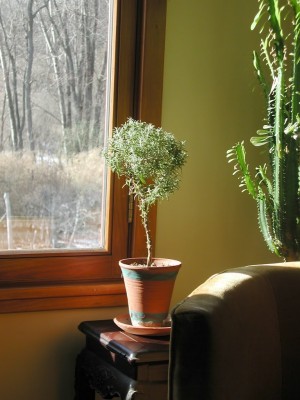
I brought this rosemary plant indoors a couple of weeks ago. With outside air streaming in through frequently opened windows and flames dancing in the woodstove only occasionally, the plant, along with other newly moved houseplants, would – should – have had time to gradually acclimate to the drier, warmer air indoors. I paid careful attention to watering, even filled the saucers beneath the pots with water to raise the local humidity and supply some water from below by capillary action.
The photo at left is of my rosemary plant pre-death.
I evidently didn’t pay enough attention to the rosemary tree. The problem with rosemary plants is that their thin, stiff leaves never wilt to show that the plants are thirsty. My plant finally showed its thirst by suddenly raining desiccated leaves to the floor as I brushed by it.
I seem to lose a (nicely trained) rosemary every few years. Fortunately, experience has taught me to always have one or more young plants in the wings awaiting just such a calamity.
***************************************
I could have such fun with this horticultural treat. My garden is going “nuts.” I’m feeling “nutty.” I’m “squirreling away” food for winter.
In this case, some of that food is actually “nuts.” Right now we have 6 half-bushel baskets filled to the brim with husked, washed, dried black walnuts. Squirrels and many of us humans are extremely fond of this nut’s rich flavor, different and much more distinctive than the English walnuts found in markets. Black walnuts are all over the place, free for the taking.
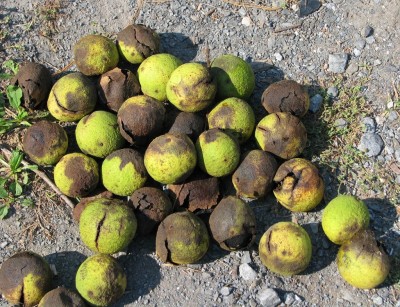
Allow me to backtrack to a week or so ago . . . That’s when black walnuts, nestled in their soft, green, tennis-ball-sized husks, started dropping in earnest. They shed heavily each year when the trees are just about leafless. Strong winds helped, of course.
The first step in preparing the nuts is to de-husk them, which my wife Deb does with the aid of rubber gloves and a light, one-hand sledge hammer. The gloves are to keep the juice, used to stain wood and clothe, from staining her hands. She dumps a few nuts on the ground, hits them with the hammer to loosen the husks, then twists the husks off, dropping the husks into one bucket and the golfball-sized nuts into another.
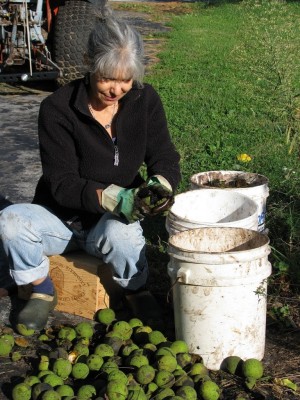
My job is to clean the husked nuts. I spread them on a screen and hose them off.
Then the nuts need to be dried, which we do by spreading them on a cloth on our sun-drenched deck. The danger here is pilfering by squirrels. Fortunately, the deck is also where Leila and Scooter, our two squirrel-hungry dogs, spend a lot of time in half sleep. We gather the nuts up into half-bushel baskets to bring indoors each night and on rainy days. The nuts are sufficiently dry, and not prone to mold, after a few sunny days.
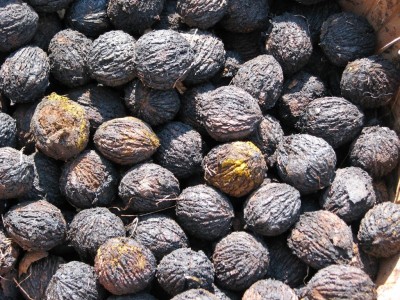
Once the nuts are dry, it is very important NOT to eat them. At least not yet, because they taste too “green.” Instead, we put them away somewhere cool and squirrel-proof to cure until January, at which point they are delicious. That is, once you get to the meat, which you can do with a hammer or – much, much more easily and with less finger trauma– with a special nutcracker. I use the “Master Nut Cracker.” Come January, I look forward to re-visiting those “nutty” baskets now in storage.
******************************************
I envy nongardeners and my pre-gardening life after nights like last night, October 14th. Everyone feels the weather generally cooling, but temperatures around freezing are critical to us gardeners. Last night, temperatures dropped to 28 degrees in my garden.
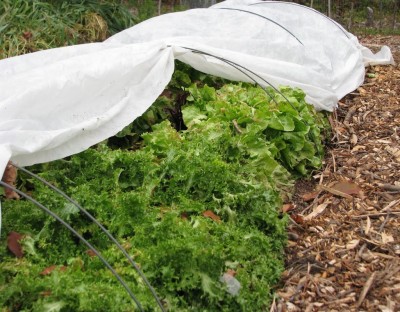
That temperature definitively signals the end of peppers, basil, summer squash, and other summer vegetables. That temperature also tells me to start readying cold weather vegetables, such as lettuce, cabbage, radishes, and arugula for even colder weather in the offing. My goal is to continue picking fresh vegetables from the garden for salads and for cooking on into December.
Today I draped floating row covers, which are lightweight fabrics permeable to water, light, and some air, over beds of cold weather vegetables. Floating row covers offer about 4 degrees of cold protection. I’ll do more when temperatures drop further.
*******************************************




We always dumped black walnuts in the driveway. A few weeks later we picked up the husked walnuts.